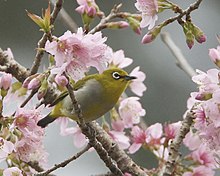Prunus cerasoides
| Prunus cerasoides | |
|---|---|

| |
| Indian white-eye in a wild Himalayan cherry | |
| Scientific classification | |
| Kingdom: | Plantae |
| Clade: | Tracheophytes |
| Clade: | Angiosperms |
| Clade: | Eudicots |
| Clade: | Rosids |
| Order: | Rosales |
| Family: | Rosaceae |
| Genus: | Prunus |
| Subgenus: | Prunus subg. Cerasus |
| Species: | P. cerasoides
|
| Binomial name | |
| Prunus cerasoides | |
| Synonyms[3] | |
|
List
| |
Prunus cerasoides, commonly known as the wild Himalayan cherry or sour cherry[4] is a species of deciduous cherry tree in the family Rosaceae.
Its range extends in the Himalayas from Himachal Pradesh in north-central India, to south-western China, Burma and Thailand. In India the tree is widely revered in the Himalayan state of Uttarakhand. The tree is found in temperate forest from 1,200–2,400 metres (3,900–7,900 ft) in elevation and extends to tropical highlands of Southeast Asia.[5][6]
Description[edit]
Prunus cerasoides is a tree which grows up to 30 metres (98 ft) in height. It has glossy, ringed bark. When the tree is not in flower, it is characterised by glossy, ringed bark and long, dentate stipules.[citation needed]
The tree flowers twice a year, during autumn and spring. First flowering blooms between the months of January to April and second flowering blooms between September to November.[7] Flowers are hermaphroditic and are pinkish white in color. It has ovoid yellow fruit that turns red as it ripens.[citation needed]
Cultivation[edit]
Prunus cerasoides thrives in well-drained and moisture-retentive loamy soil, in an open, sunny, and sheltered location.[citation needed]
P. cerasoides, like most members of the genus Prunus, is shallow rooted and is likely to produce suckers if the root is damaged. It is likely to become chlorotic if too much lime is present. It is known to be susceptible to honey fungus.[citation needed]
The seed requires two to three months cold stratification and is best sown in a cold frame as early in winter as possible. The seed grows rather slowly and can sometimes take about 18 months to germinate depending on the conditions.[citation needed]
Culture[edit]
In India, Prunus cerasoides is known in Hindi as padam, pajja, pahhiya or padmakashtha has cultural and religious significance.[8][9] Among Hindus in Himachal Pradesh and Uttarakhand, it is considered sacred and associated with Vishnu and Shiva.[10][11][12] During Maha Shivaratri, the leaves are used to make a wreath with wild citrus fruits, which is hung at the prayer altar. The leaves are also used as incense.[13][14] Village weddings are considered incomplete without having been decorated with the branches and leaves from the tree.[10] The use of its wood in the wedding hall symbolizes strength and happiness in the new life of the bride and groom.[10] Among the instruments played in religious ceremonies, lukudi made from the wood of pahhiya tree is considered to be the most sacred.[10]
In Hindi and Sanskrit it is known as padma, padmakh, pajja, pahhiya, padmakashtha, charu, hima, kaidra, padmagandi. In Nepali it is known as paiyu. In Khasi and Mizo languages it is known as dieng kaditusoo and tlaizawng.[8]
Prunus cerasoides cherry blossom festivals are held in India during the months of October–November.[15] Shillong is notable for its annual prunus cerasoides cherry blossom festival held during the month of November.[16][17]
Uses[edit]
Food[edit]
- Fruit — 15mm in diameter, the fruit can be eaten raw or cooked.
- Gum — Gum is chewed and obtained from the trunk. It can be employed as a substitute for gum tragacanth.
- Seed — It can be eaten raw or cooked.
Other uses[edit]
The fruits and the leaves give a dark green dye. Seeds can be used in the manufacture of necklaces.
The wood is hard, strong, durable and aromatic, and branches are used as walking sticks.
References[edit]
- ^ Rhodes, L.; Pollard, R.P.; Maxted, N. (2016). "Cerasus cerasoides". IUCN Red List of Threatened Species. 2016: e.T50026860A50670270. doi:10.2305/IUCN.UK.2016-3.RLTS.T50026860A50670270.en. Retrieved 9 February 2023.
- ^ "Plant Name Details for Prunus cerasoides D.Don". IPNI. Retrieved September 16, 2009.
- ^ See Taxonbar
- ^ "Prunus cerasoides". Germplasm Resources Information Network. Agricultural Research Service, United States Department of Agriculture. Retrieved January 24, 2014.
- ^ Chandel, V.; Rana, T.; Hallan, V.; Zaidi, A. A. (2007). "Wild Himalayan Cherry (Prunus cerasoides) as a Natural Host of Prunus necrotic ringspot virus in India". Plant Disease. 91 (12): 1686. doi:10.1094/PDIS-91-12-1686C. PMID 30780621.
- ^ "Prunus cerasoides - Useful Tropical Plants". tropical.theferns.info.
- ^ Kurniawan, V (16 May 2021). "Phenology and morphological flower of Prunus cerasoides Buch.-Ham. Ex D. Don". IOP Conference Series: Earth and Environmental Science. 948 (1): 8. Bibcode:2021E&ES..948a2047K. doi:10.1088/1755-1315/948/1/012047. S2CID 245259406. Retrieved 16 May 2021.
- ^ "Prunus cerasoides". Germplasm Resources Information Network. Agricultural Research Service, United States Department of Agriculture. Retrieved 24 January 2014.
- ^ a b c d Tree, Kafal (2020-12-23). "पैयाँ की टहनियों बिना पहाड़ियों की शादी का मंडप अधूरा रहता है". Kafal Tree. Retrieved 2024-01-31.
- ^ Trees In Indian Art Mythology And Folklore, Bansi Lal Malla (2000), p.56
- ^ Joseph, Nino. "Prunus cerasoides D. Don: A Review on Its Ethnomedicinal Uses, Phytochemistry and Pharmacology". researchgate. International Journal of Pharmaceutical Sciences Review and Research. Retrieved 14 January 2018.
- ^ Verma, Shruti (13 February 2018). "Celebrating Shivratri the Pahari style". himvani.com. Retrieved 13 February 2018.
- ^ Jishtu, Vaneet (6 December 2016). "Padmakh (Pajja) – An Amazing Native Autumn Flowering Tree From Shimla Hills". hillpost.in. Retrieved 6 December 2016.
- ^ Banerjee, Ananda (11 November 2016). "Cherry blossom festival". Livemint. Retrieved 12 Nov 2016.
- ^ Kamei, Precious. "Shillong Cherry Blossom Festival". outlookindia. Retrieved 13 December 2018.
- ^ Shahani, Shradha (2 November 2018). "Cherry blossom festival takes place this month". cntraveller. Retrieved 2 November 2018.

